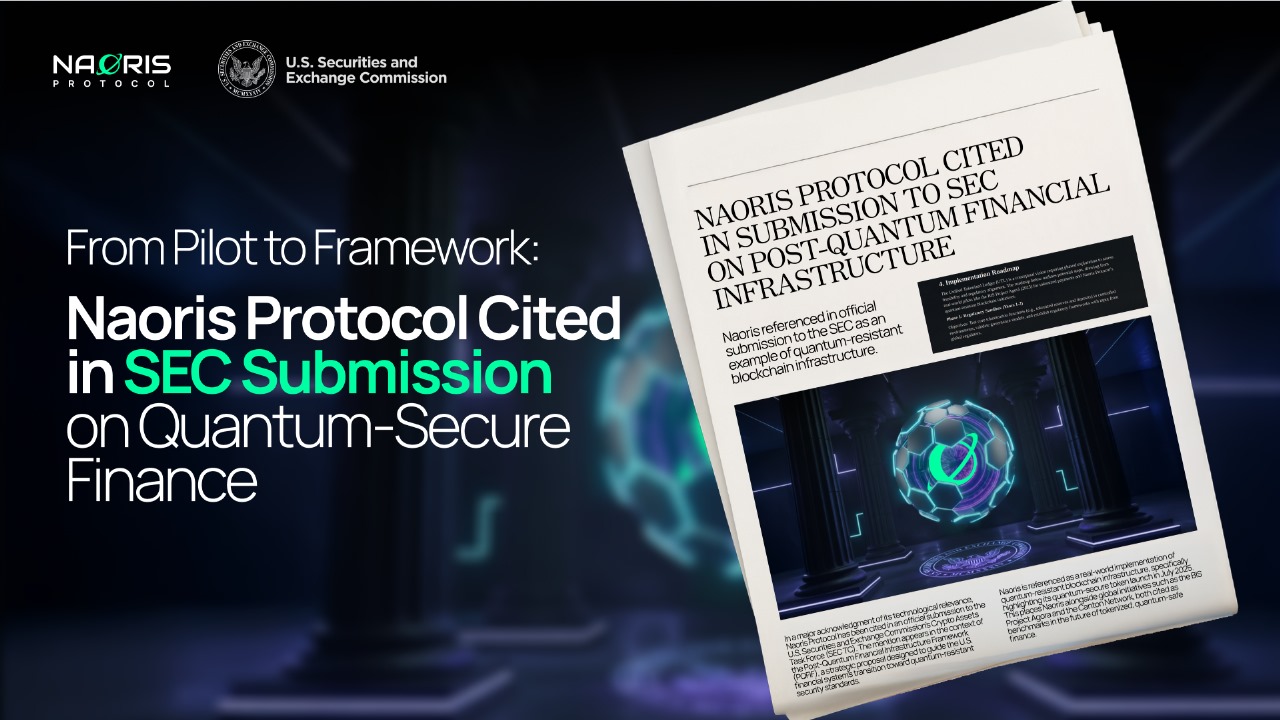Naoris Protocol cited in Submission to SEC on Post-Quantum Financial Infrastructure

A Signal to Washington
In September 2025, an independent analyst submitted a 63-page report to the U.S. Securities and Exchange Commission’s (SEC) Crypto Assets Task Force.
The report — Post-Quantum Financial Infrastructure Framework (PQFIF) — examines how the financial industry should prepare for the coming quantum threat. It cites Naoris Protocol ($NAORIS) as a reference model for post-quantum resilience in three key areas:
- Implementation Standards (p.66–68) – The framework references Naoris Protocol’s quantum-secure blockchain pilots as examples of how post-quantum infrastructure can be integrated into financial systems, aligning with scalability and implementation benchmarks.
- Timeline Benchmarks (p.68) – Naoris Protocol is cited within the phased roadmap for post-quantum cryptography migration, highlighting live pilots as part of the assessment and pilot stages that regulators expect to see before production rollout.
- Privacy References (p.71–72) – The report points to Naoris Protocol’s application of advanced cryptography, including zero-knowledge proofs, as an example of privacy-preserving techniques that support regulatory compliance and data protection.
While this is not an official SEC endorsement, the fact that Naoris Protocol is highlighted underscores a simple truth: our work is shaping the conversation at the highest levels of financial regulation.
Why This Matters
The urgency is real. Experts estimate a 17–34% probability that RSA-2048 encryption could be broken by quantum computers by 2034. Europol has already warned “Q-Day” may arrive as early as 2028.
The SEC report echoes what Naoris has long said: Web2 and Web3 infrastructures must migrate to post-quantum security now, before harvest-now-decrypt-later attacks compromise trillions in financial assets and sensitive data.
Key threats highlighted:
- Institutional Bitcoin & Ethereum wallets (ECDSA)
- Custody systems managing billions in assets
- DeFi protocols, bridges, and validators
- Customer data requiring decades of protection
Naoris Protocol’s Head Start
Naoris Protocol is uniquely positioned because we are operational today, not theoretical.
Our Sub-Zero Layer integrates NIST-approved post-quantum cryptography (ML-KEM, ML-DSA, SLH-DSA) into existing blockchains without forks or disruption.
Our dPoSec consensus transforms every node into a security validator, continuously verifying device health, code integrity, and transaction trust.
Since launching our testnet:
- 100M+ post-quantum transactions processed
- 3.3M+ wallets created
- 1M+ validator nodes activated
- 550M+ threats mitigated in real time
The $NAORIS token launch in July 2025 was only the ignition point. It marked the beginning of the road to Mainnet, where Naoris Protocol will fully power the world’s first post-quantum blockchain. Mainnet is the destination: embedding continuous proof-of-security beneath blockchains, enterprises, and billions of devices.
Implications for the Industry
The PQFIF report lays out a roadmap:
- Assessment Phase: Evaluate current pilots → Naoris cited as a benchmark.
- Pilot Phase: Test quantum-secure rollouts → July 2025 launch cited.
- Production Phase: Deploy industry-scale models → Naoris positioned as a model.
The U.S. government estimates $7.1B will be spent on post-quantum migration by 2035. Private-sector costs will run tens of billions more. With 20B devices needing upgrades, the scale of this shift is unprecedented.
For Web3, this is a wake-up call:
- Protocols will need to prove their quantum resilience.
- Institutional adoption will favor quantum-ready infrastructure.
- A bifurcation may emerge between institutional-grade quantum-secure protocols (like Naoris) and legacy retail solutions.
What This Means for Builders and Investors
For developers, the message is clear: post-quantum security is no longer optional. As more institutions and regulators look for reference models, solutions like Naoris Protocol set the bar for trust, compliance, and scalability.
For investors and token holders, this recognition reinforces the long-term significance of $NAORIS as a value-accruing asset tied to securing critical infrastructure. The token is not only a mechanism for rewards and governance, but also a direct driver of trust validation at scale — a function that will grow more essential as “Q-Day” approaches.
Looking Ahead
The SEC report highlights what we’ve always believed: trust is the new battleground for digital infrastructure.
Being cited in this framework is not just recognition — it’s proof that the work of Naoris Protocol is aligned with the future regulators expect.
As quantum computing advances, one thing is certain: the industry cannot wait until Q-Day. The shift must happen now. And Naoris Protocol is building the reference infrastructure to make that future secure, resilient, and quantum-ready.
About Naoris Protocol
Naoris Protocol is revolutionizing cybersecurity and digital trust with the world's first Decentralized Post-Quantum Infrastructure, operating at the Sub-Zero Layer, below layers L0 to L3 it secures blockchain transactions and Web3 & Web2 infrastructure, including DEXes, bridges, and validators, enterprise cloud and IoT networks. By transforming every device into a trusted validator node, our Post-Quantum infrastructure leverages the cutting-edge dPoSec consensus and Decentralized Swarm AI, to set a new standard in transparency, trust, and security, preparing Web3 and Web2 for a Post-Quantum future.
Led by industry experts and cyber pioneers adding decades of experience who are committed to advancing the frontiers of cybersecurity and trust, here’s some of our trusted advisors;
- David Holtzman: former CTO of IBM and architect of the DNS protocol
- Ahmed Réda Chami: Ambassador for Morocco to the EU. Former CEO Microsoft North Africa
- Mick Mulvaney: Former White House Chief of Staff
- Inge Kampenes: Former Chief of Norwegian Armed Forces & Chief of Cyber Defence adding decades of experience who are committed to advancing the frontiers of cybersecurity and trust.







